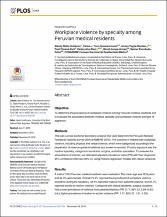| dc.contributor.author | Nieto-Gutierrez, Wendy | |
| dc.contributor.author | Toro-Huamanchumo, Carlos J. | |
| dc.contributor.author | Taype-Rondan, Alvaro | |
| dc.contributor.author | Timaná-Ruiz, Raúl | |
| dc.contributor.author | Alva Diaz, Carlos | |
| dc.contributor.author | Jumpa-Armas, David | |
| dc.contributor.author | Escobedo-Palza, Seimer | |
| dc.contributor.author | CONAREME Consejo Nacional de Residentado Médico | |
| dc.date.accessioned | 2020-05-28T20:18:07Z | |
| dc.date.available | 2020-05-28T20:18:07Z | |
| dc.date.issued | 2018-11-29 | |
| dc.identifier.citation | Nieto-Gutierrez W., Toro-Huamanchumo CJ., Taype-Rondan A., Timaná-Ruiz R., Alva C., Jumpa-Armas D., et al. Workplace violence by specialty among Peruvian medical residents. PLoS One. 2018; 13(11):e0207769. | es_PE |
| dc.identifier.uri | https://hdl.handle.net/20.500.12727/6116 | |
| dc.description.abstract | Objective
To determine the prevalence of workplace violence among Peruvian medical residents and to evaluate the association between medical specialty and workplace violence per type of aggressor.
Methods
This was a cross-sectional secondary analysis that used data from the Peruvian Medical Residents National Survey 2016 (ENMERE-2016). The outcome of interest was workplace violence, including physical and verbal violence, which were categorized according to the perpetrator of violence (patients/relatives and worker-to-worker). Primary exposure was the medical specialty, categorized as clinical, surgical, and other specialties. To evaluate the associations of interest, we estimated adjusted prevalence ratios (PR) with their respective 95% confidence intervals (95% CI) using Poisson regression models with robust variances.
Results
A total of 1054 Peruvian medical residents were evaluated. The mean age was 32.6 years and 42.3% were female. Overall 73.4% reported having suffered of workplace violence sometime during the residency, 34.4% reported violence from patients/relatives, and 61.1% reported worker-to-worker violence. Compared with clinical residents, surgical residents had a lower prevalence of violence from patients/relatives (PR: 0.71; 95% CI: 0.59–0.87), but a higher prevalence of worker-to-worker violence (PR: 1.11, 95% CI: 1.01–1.23).
Conclusion
Nearly three quarters of medical residents reported having suffered workplace violence sometime during their residency. Compared with clinical residents, surgical residents had lower rates of violence from patients/relatives, but higher rates of worker-to-worker violence; while residents from non-clinical and non-surgical specialties had a lower prevalence of both types of violence. | es_PE |
| dc.format.extent | pp. e0207769 | es_PE |
| dc.language.iso | eng | es_PE |
| dc.publisher | Gerard Hutchinson, University of the West Indies at Saint Augustine | es_PE |
| dc.relation.ispartof | urn:issn:0717-7526 | |
| dc.relation.ispartofseries | PLoS ONE;vol. 13, no. 11 | |
| dc.relation.uri | https://doi.org/10.1371/journal.pone.0207769 | es_PE |
| dc.rights | info:eu-repo/semantics/openAccess | es_PE |
| dc.rights.uri | https://creativecommons.org/licenses/by/4.0/ | es_PE |
| dc.source | Repositorio Académico USMP | es_PE |
| dc.source | Universidad San Martín de Porres - USMP | es_PE |
| dc.subject | Violencia laboral | es_PE |
| dc.subject | Estadística | es_PE |
| dc.subject | Psicología | es_PE |
| dc.subject | Internado y residencia | es_PE |
| dc.title | Workplace violence by specialty among Peruvian medical residents | es_PE |
| dc.type | info:eu-repo/semantics/article | es_PE |
| thesis.degree.name | Medicina Humana | es_PE |
| thesis.degree.grantor | Universidad de San Martín de Porres. Facultad de Medicina Humana | es_PE |
| thesis.degree.discipline | Medicina | es_PE |
| dc.subject.ocde | https://purl.org/pe-repo/ocde/ford#3.02.00 | es_PE |








